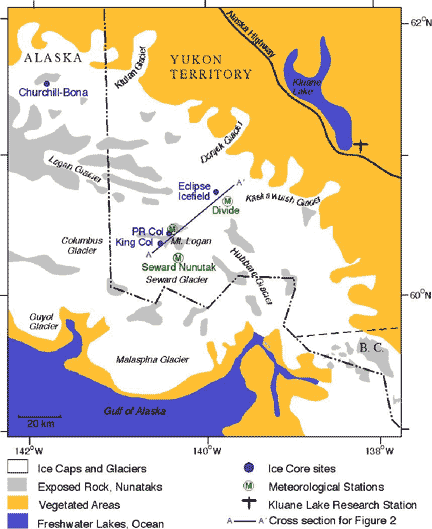Research Problem and Objectives
The Arctic represents one of the key regions on Earth in our efforts to document and understand global change. The sensitivity of the Arctic to climate perturbations and the wealth of paleoenvironmental records available from this region justifies the prominent role the Arctic plays in global change research. The Arctic is experiencing changes in atmospheric and oceanic circulation related to natural climate variability and to anthropogenic greenhouse gas/sulfate aerosol forcing. These changes extend from the top of the atmosphere to below 1000 m depth in the ocean and include observations of decreased sea ice cover, a rise in the North Atlantic Oscillation atmospheric circulation index, reduced formation of North Atlantic Deep Water, and warming over the subpolar land areas of Alaska and northwest Canada in winter and spring. Understanding our contemporary environment and predicting future change requires an understanding of changes in the past, providing not only the basis to investigate linkages between the physical climate system and different forcing factors but also providing critical boundary conditions for testing and improving global circulation models.

To properly interpret glaciochemical records developed from the new St. Elias ice cores, calibration of snow properties with meteorological data (temperature, precipitation, sea level pressure) is critical. At the Divide Site (Fig. 1; 2800 masl), two automatic weather stations have been operating since 2002, collecting snow depth as well as standard meteorological data. Therefore, the timing of snow accumulation over the past 3 years is known precisely, providing a unique opportunity to investigate the atmospheric controls on snow deposition and chemistry in the St. Elias Mountains. Our first objective is to dig and sample a 6-meter snowpit underneath the AWS station, collect samples for stable isotope, major ion, and trace element analysis, and interpret the physical stratigraphy observed in the snowpit. Our second objective is to return the samples frozen to UMaine, and conduct chemical analysis. Our third objective is correlate meteorological and snowpit chemical records, and interpret the basic atmospheric processes controlling snowpack properties in the St. Elias.
Fieldwork Details and Schedule
The fieldwork proposed here is an international collaborative effort among groups from UMaine, the University of Ottawa (UO), and the GSC. The UMaine group will join Dr. C. Zdanowicz (GSC), who has extensive glaciological research experience in the St. Elias Mountains, as well as an undergraduate glaciological course (~10 participants) led by Dr. P. Johnson (UO). The entire team plans to spend roughly 1 week at the Divide site, collecting meteorological data and snow chemistry samples. Based on past experience in the area, our overall schedule includes four anticipated weather delay days.
June 10: Bangor - Whitehorse (travel)
June 11: Whitehorse - Kluane Lake (travel)
June 12-15: Kluane Lake (equipment preparation)
June 16: Kluane Lake - Divide (travel)
June 17-24: Divide (AWS data collection and snowpit sampling)
June 25: Divide - Kluane Lake
June 26: Kluane Lake - Whitehorse
June 27: Whitehorse - Bangor
Budget and justification
The proposed budget includes roundtrip travel costs (flights, ground transportation, per diem, and field supplies) for two people from Bangor to the research site in the St. Elias Mountains. Other costs associated with the project (sample analysis) will be covered as part of ongoing NSF research (K. Kreutz, PI). Benefits of the research project include unique field experiences in a remote location and laboratory experience for two UMaine students, as well as a significant contribution to international ice core research efforts in the St. Elias region.
